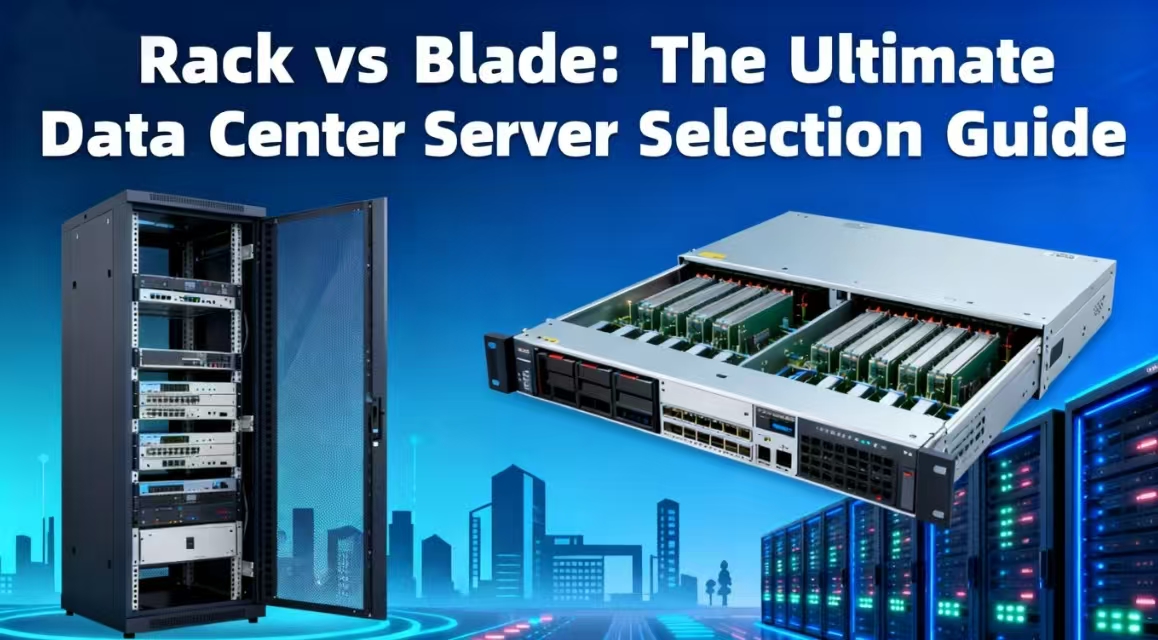Rack Server vs Blade Server: The Ultimate Decision-Making Guide for Data Center Server Selection
When building or upgrading a data center, a core and unavoidable question is: Do you choose Rack Servers or Blade Servers? The debate of rack server vs blade server has persisted for years, but the answer isn't a simple matter of which is better. It's about when, where, and why to choose one over the other. This article serves as your ultimate decision-making guide, providing an in-depth analysis of the pros and cons to help you make the smartest investment.
Meet the Contenders – Differences in Foundational Architecture
Before diving into the comparison, let's quickly understand their basic forms.
-
Rack Servers: The independent, modular heroes. They are self-contained units that slide horizontally into a standard equipment rack. Each is a fully functional, standalone unit with its own power supplies, networking, management modules, and cooling system.
-
Blade Servers: The highly integrated army. They slot into an enclosure called a "blade chassis." Each blade server contains only the core computing components like CPUs, memory, and drives, while infrastructure like power, networking, management, and cooling is shared and provided centrally by the chassis.
This fundamental architectural difference directly dictates their performance, cost, and application scenarios.
Head-to-Head – An In-Depth Comparison Across 5 Key Dimensions
Density and Space Efficiency
-
Rack Servers: Moderate density. While density can be improved with multi-node servers, each node is often still relatively independent. Deploying a large number of servers in a limited space can lead to challenges in cabling and management.
-
Blade Servers: The king of high-density computing. A single blade chassis can hold multiple blade servers, drastically saving physical space. For data centers where space is at a premium, blade servers hold a significant advantage in the density aspect of scalability rack server and blade.
Cabling and Management Simplicity
-
Rack Servers: A potential source of "cabling nightmares." Each server requires its own independent power cords, network cables, and management cables. Managing dozens or hundreds of servers can become a heavy operational burden.
-
Blade Servers: A paradigm of simplicity. They connect via the chassis's backplane, requiring only a few power and aggregated network cables for the entire chassis. Unified management modules also make "ease of management" a core advantage in data center server selection criteria.
Performance and Scalability
-
Rack Servers: Greater flexibility and independence. Each server can be customized for specific needs (e.g., installing full-height, full-length GPU cards or special I/O cards). When it comes to the flexibility aspect of scalability rack server and blade, rack servers come out ahead.
-
Blade Servers: Are limited by the chassis specifications, and choices for expansion cards are often physically constrained. However, their internal high-speed backplane interconnect enables low-latency, high-bandwidth communication between blades, making them ideal for tightly-coupled cluster computing.
Cooling and Power Consumption
-
Rack Servers: Cooling is relatively straightforward, with each server having its own fans. However, overall heat dissipation and power consumption become significant challenges in high-density deployments.
-
Blade Servers: The chassis shares efficient, centralized cooling systems, which are optimally designed. However, because the power density is extremely high, the power and cooling requirements for a single chassis are very concentrated, placing greater demands on the data center's power and cooling infrastructure.
Cost Considerations – It's More Than Just the Purchase Price
This is the most critical part of the decision. We must look beyond the initial purchase price and examine the total cost of ownership blade vs rack.
-
Initial Cost: Rack servers typically have a lower initial investment and can be purchased individually as needed. Blade systems require a significant upfront investment in the expensive chassis, creating a higher barrier to entry.
-
Total Cost of Ownership (TCO): Blade servers can yield significant cost savings in long-term operations. Simplified cabling, centralized management, and higher space efficiency can drastically reduce labor costs and data center rental costs. Therefore, at a certain scale, the TCO of blades can become more advantageous.
The Decision – When to Choose Blade Over Rack Server?
So, precisely when to choose blade over rack server?
Choose Blade Servers when you:
-
Require Maximum Computing Density: Space is limited, and you need to deploy the most computing units in the smallest physical footprint.
-
Need Simplified Operations and Management: You want to drastically reduce cabling and manage a large number of servers through a unified interface.
-
Have Highly Homogeneous Workloads: You are running large-scale virtualization, HPC (High-Performance Computing), or web farms where node configurations are similar.
-
Possess Robust Infrastructure: Your data center can provide adequate power and cooling for the high-power-density blade chassis.
Choose Rack Servers when you:
-
Require High Customization: Servers need to house specialized hardware, like powerful GPUs, FPGA cards, or a large number of hard drives.
-
Have Diverse Workloads: Different applications require servers with different configurations; the independence of rack servers is better suited for this mixed environment.
-
Are Budget-Conscious or Have a Smaller Scale: Initial investment is limited, or the number of servers is low, making a complex blade system unnecessary.
-
Prefer Incremental Expansion: You want to add servers one by one as needed, without a large upfront investment.
No Ultimate Winner, Only the Best Choice
The debate between rack servers and blade servers is essentially about finding the right balance between flexibility, density, and cost. Rack servers are the versatile and flexible "Swiss Army knives," suitable for the vast majority of scenarios. Blade servers are the highly optimized "precision instruments," offering unparalleled advantages in specific large-scale, high-density scenarios.




